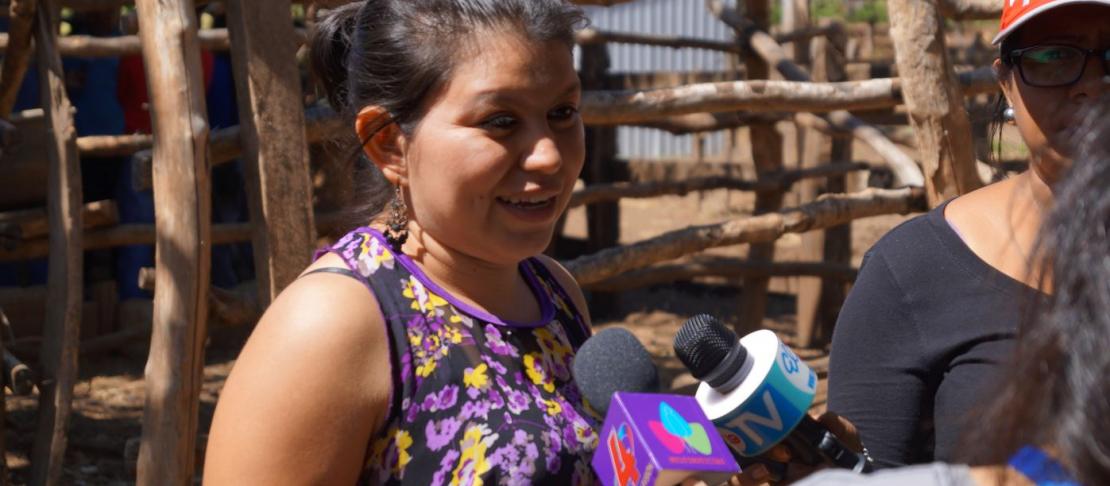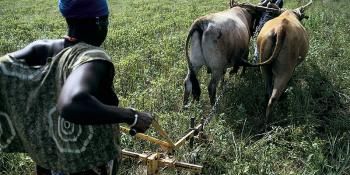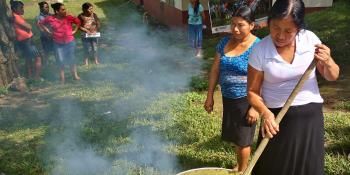Nicaraguan women: producers and researchers

Improved seeds, organic fertilizers and water harvesting techniques are just a few of the technologies that Mariela Arteaga uses on her farm.
Mariela greats us, wide eyed and smiling amiably, to her 3.5 hectare farm located in the town of El Boneño, within the municipality of Diriamba, Nicaragua. It is here that this young woman, well known for her proactive farming techniques, grows improved animal forage and a variety of fruit trees.
If you want to know more about research on closing the gender gap in farming under climate change:
- read our special blog series on Closing the gender gap
- watch the presentations and the panel discussion from the Closing the gender gap event
- follow the #AgGenderGap event hashtag on twitter
One of the first things I noticed, right outside her house, were two concrete structures that I learned hold large amounts of water which is used for crop irrigation. I was further impressed by the fact that tilapia are raised within these water collection tanks and act as biological control agents in an effort to eradicate mosquito larvae.
Mariela Arteaga’s innovative production systems are supported by the Nicaraguan Institute of Agricultural Technology (INTA in Spanish). With their assistance, the farm is able to be a place for knowledge exchanges, where agroecological practices and the sustainable management of the Earth's natural resources can be conducted.
During our time together, Mariela spoke about the difficulties associated with being a female farmer and happily recounted one of her her first experience with INTA and a research project they would be jointly conducting. "Last year was working on validating a new seed technology which focused on a special type of bean called 'Inta Fuerte Sequía or Hard Drought Bean'. This bean was supposed to be very drought resistant, heat tolerant and fast growing with a maturation rate of 80 days. We were also working with a variety of tomato called 'SER 16'. Overall the experience was very informative as I had never cultivated tomatoes before."
The SER 16 tomato variety aimed to control whiteflies and while still be an appropriate planting choice for the dry region. Mariela was able to successfully cultivate and harvest 35 boxes of whitefly free tomatoes per hectare through the use of agro-ecological management.
Additionally, the Hard Drought Bean was confirmed as an improved seed variety when compared to other grains that were traditionally sown in the area. On Mariela’s farm these beans yielded of up to 1.8 tonnes per hectare. According to Pedro Bustos, INTA's technical innovator for the municipality of Diriamba, this is a dramatic increase for the 0.7 tons per hectare generally produced by local farmers in the area.
OUTSIDE HER HOME, CONCRETE WATER STORAGE UNITS, EACH ABLE TO HOLD 110 BARRELS OF WATER USED FOR CROP IRRIGATION. PHOTO: INTA
Food for livestock
It's summer time and strong winds are whipping through the nearby cow pasture where 'Gamba', 'Taiwán', 'Camerún' and 'Estrella' are waiting to be fed freshly chopped grass. Even in April the cows will eat this same grass, as it will be stored in silos and mixed with molasses, a fermentation process known as silage, to make it more palatable.
"We are going to make high nutrient fertilizer blocks through the process of ammonification (adding ammonia) to peanut, sorghum, and bean residues, or stubble, left over from the harvest" expressed Mariela, while pointing to the fertilizer blocks stacked behind the house. A delegate of INTA within the Carazo department was also happy to inform me that Mariela would be receiving additional training on silage, fodder preservation through fermentation.
With in the past year, this young farmer has developed a farm plan in coordination with INTA which includes 400 meters of contour plowing, improved irrigation, the planting of hedgerows, and increased organic compost production.
"Now that farmers have the support of INTA, I am learning thing I didn’t know before; I'm learning bit by bit and we are grateful that they have supported subsistence farms and farmers" concluded Mariela.
Maricely Linarte is editor of the Nicaraguan Institute of Agricultural Technology. This article was crossposted with permission from its publication on the INTA website. Read the original in Spanish.
Edited by José Luis Urrea, Communications Officer for CCAFS Latin America.




